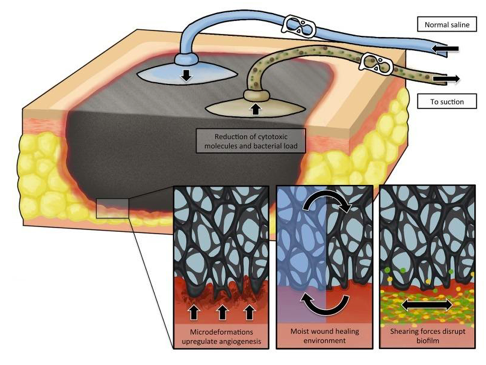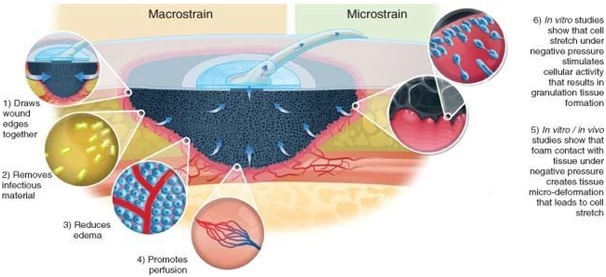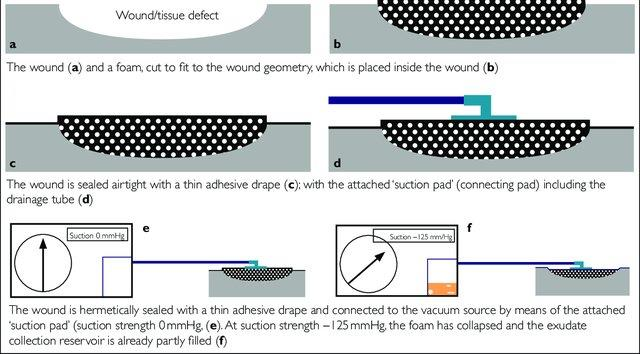
NEGATIVE PRESSURE WOUND THERAPY WITH IRRIGATION
The use of negative pressure wound therapy (NPWT) is well established in the treatment of chronic wounds. NPWT with instillation (NPWTi) combines traditional NPWT with the application of a topical irrigation solution within the wound bed. The addition of instillation feature with NPWT adds several potential benefits in dealing with complex wounds.
NPWT WITH IRRIGATION -MECHANISM OF ACTION
Potential mechanisms of action include the removal of microorganisms from the wound surface, dilution of cytotoxic molecules, up-regulation of angiogenesis pathways, and maintenance of a moist wound environment. As we have extended our use of these devices to more complex wounds, we have taken advantage of and observed potential mechanisms of action, including facilitated removal of microorganisms, dilution of inflammatory and cytotoxic macromolecules, additional wound hydration, and enhanced angiogenesis through an intermittent application of NPWT.
Fig 2. NPWTi MECHANISM OF ACTION
INDICATIONS
Several different types of wounds can benefit from negative pressure wound therapy such as:
-
Trauma wounds
-
Dehisced wounds
-
Chronic wounds
-
Abdominal compartment syndrome
-
Pre & post-op flaps/grafts
-
Diabetic ulcers
-
Venous ulcers
-
Arterial ulcers
-
Pressure ulcers
-
Burn wounds
-
Wounds with large amounts of drainage
-
Surgical and acute wounds at high risk for infection
CONTRAINDICATIONS
CCNPWT is contraindicated for below:
-
Malignancy in wound
-
Necrotic tissue with eschar
-
Untreated osteomyelitis
-
Fistulas to organs or body cavities
-
Do not place NPWT dressing over
exposed arteries or veins
CCNPWT ADVANTAGES
The use of Negative Pressure Wound Therapy system in Chronic Wounds, Venous Ulcers, Diabetic Ulcers, Traumatic Wounds, Post-Operative and Dehisced Surgical Wounds provides a moist wound environment at the wound site thus:
-
Enhances dermal perfusion, decompresses blood vessels.
-
Reduces bacterial colonization.
-
Promotes micro angiogenesis.
-
Promotes uniform granulation tissue formation.
-
Enhances blood circulation in pressure ulcers.
-
Reduces communicable infection rate.
-
Improves bed hygiene as it is a closed system.
-
Less pain full than the daily dressing change for the patient.
-
Early usage of NPWT may save limbs in case of diabetic foot and other chronic wounds.
-
Requires lesser nursing time as dressing needs to be changed only after 4 – 5 days and saves man hours.
-
Early usage of NPWT may save limbs in case of diabetic foot and other chronic wounds.
-
Lesser antibiotic usage enhances patient immunity and also cost to the hospital and to the society.
-
Enhances faster bed rotation in Govt. Hospitals where queue of the hospital bed is huge as patients can be discharged early.
-
Reduces overall treatment cost and time for the patient & Govt. as the hospitalization time decreases by 2/3rd with the use of NPWT
-
Improves quality of life of the patient.
-
It prevents spread of infection to the patient family/ visitors as well as to the neighbouring patients
With all the above advantages Negative Pressure Wound Therapy system would definitively help the patients & staff of your prestigious institutions.
CONCLUSION
The low-income countries like INDIA are having a number of issues related to public health. The use of NPWT in the Indian studies has not been reported extensively. Only few Indian studies have provided insights into the NPWT use in Indian setting. The use of CCNPWT is definitely having an advantage in countries like India, where the patient load on the health centres is very high and where more than 40% of the population earns less than one US dollar per day and where only a small portion of government budget goes to health there is an urgent need of faster and cheaper wound healing techniques.
The health care information about the newer and cheaper techniques will help a great deal in the exponentially growing population. In such a scenario any wound healing technique that will work faster than the conventional techniques and deliver at par or at times better results is definitely a boon. As discussed above in the document CCNPWT has certain advantages like it is easy to handle, hospital admission is not essential, good patient compliance and satisfaction, require minimal training to maintain vacuum at home, can be applied to multiple cases at the same time and give adequate mobility to the patient.
CCNPWT will also reduce the total time spent in the hospital and this is ideal for already overloaded hospitals. Besides, the number of follow-ups will also be reduced in cases involving CCNPWT. But the situation in the rural areas is graver as NPWT is not available everywhere in the developing countries and the usage of NPWT in the rural areas is very difficult due to difficulties related to terrain, availability of devices, cost issues, etc. Thus we highly recommend the use of CCNPWT for wound management which can be used in the rural areas of developing countries is essential. The data available from scientific literature suggest that Negative Pressure Wound Therapy to be a cost-effective technique, resulting in at par or at times better wound healing.


